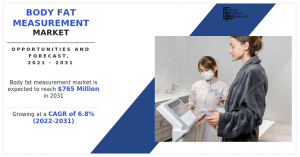
 USA, UK , Singapore Body Fat Measurement Market PORTLAND, OREGON, UNITED STATES, September 8, 2023/EINPresswire.com/...
USA, UK , Singapore Body Fat Measurement Market PORTLAND, OREGON, UNITED STATES, September 8, 2023/EINPresswire.com/... PORTLAND, OREGON, UNITED STATES, September 8, 2023/EINPresswire.com/ — : https://www.alliedmarketresearch.com/request-sample/11261
Introduction:
The body fat measurement market has witnessed significant growth in recent years, driven by increasing awareness of the importance of maintaining a healthy body composition. 2021, $395.13 , and it is poised for remarkable expansion, projected to reach $765.00 2031. This substantial growth is expected to be sustained with a Compound Annual Growth Rate () 6.8% 2022 2031, making it a promising sector for investors and healthcare professionals alike.
Factors Driving Market Growth:
1. Health and Fitness Awareness: Growing health consciousness among individuals is a primary driver for the body fat measurement market. With an increasing emphasis on maintaining a healthy lifestyle, people are seeking effective ways to monitor their body fat levels.
2. Obesity Epidemic: The rising global prevalence of obesity has fueled the demand for accurate body fat measurement tools. Obesity is a known risk factor for various chronic diseases, making it essential for individuals to track their body fat percentages.
3. Advancements in Technology: Technological innovations have led to the development of more precise and convenient body fat measurement devices. These innovations are making it easier for healthcare providers and individuals to monitor body composition accurately.
4. Fitness Industry Growth: The fitness industry’s expansion, coupled with the demand for personalized fitness plans, has created a need for accurate body fat assessment. Personal trainers, nutritionists, and fitness enthusiasts are increasingly relying on body fat data to tailor fitness regimens and dietary plans.
5. Medical Applications: Body fat measurement is not limited to fitness; it plays a crucial role in medical diagnoses and treatment planning. Healthcare providers are using these measurements to assess and manage conditions such as diabetes, cardiovascular diseases, and hormonal imbalances.
6. Nutritional Awareness: Nutritionists and dietitians are incorporating body fat measurements into their assessments to provide more targeted nutritional guidance. Understanding an individual’s body composition aids in creating customized meal plans.
Future Prospects:
As we look ahead to 2031, the body fat measurement market is expected to witness several exciting developments. These include:
1. Integration with Wearable Devices: Body fat measurement technology is likely to become more accessible through the integration of sensors in wearable devices like smartwatches and fitness trackers.
2. Artificial Intelligence and Machine Learning: AI and ML algorithms will continue to enhance the accuracy and interpretability of body fat measurements, making them more valuable for individuals and healthcare professionals.
3. Telehealth Integration: With the growth of telehealth services, remote body fat measurement solutions will gain prominence, allowing healthcare providers to monitor patients’ body composition from afar.
4. Customized Wellness Ecosystems: Companies will offer holistic wellness ecosystems that combine body fat measurements with other health metrics, creating more comprehensive health management solutions.
Key Market Players
, , , ., , , ., .., , , ( ), ., .., , , ., , , , ., . ( ., .),
End Users:
The body fat measurement market caters to a diverse range of end users, each with distinct needs and preferences:
1. Hospitals and Clinics:
• Hospitals and clinics utilize body fat measurement tools for medical assessments, patient monitoring, and treatment planning.
• These settings often require high-precision measurement techniques, such as Dual-Emission X-ray Absorptiometry (DEXA), to assess patients’ body fat composition accurately.
2. Fitness Clubs and Wellness Centers:
• Fitness clubs and wellness centers employ body fat measurement devices to offer personalized fitness and dietary guidance to their clients.
• These establishments may use various products like body scales and bioimpedance analysis machines for routine body fat assessments.
3. Home Users:
• The availability of user-friendly body fat measurement devices has made it convenient for individuals to monitor their body composition at home.
• Products like body scales and handheld calipers are popular among home users for self-assessment and tracking progress.
Products: The body fat measurement market offers a range of products to cater to the diverse needs of end users:
1. Calipers:
• Calipers are handheld devices used to measure skinfold thickness at specific body sites.
• They are a cost-effective option for assessing body fat, often used in fitness clubs, wellness centers, and by individuals at home.
2. Body Scales:
• Body scales are commonly found in both healthcare settings and households.
• Modern body scales often incorporate bioimpedance analysis technology, allowing users to measure body fat percentage in addition to weight.
3. Others:
• This category encompasses various specialized devices, including handheld bioimpedance analyzers, infrared devices, and more.
• These devices may offer additional features such as muscle mass and hydration level measurements.
Techniques: The accuracy of body fat measurement depends on the technique used. Several techniques are employed in the market:
1. Bioimpedance Analysis (BIA):
• BIA measures the body’s resistance to a low-level electrical current, providing estimates of body fat percentage.
• This non-invasive technique is commonly found in body scales and handheld devices.
2. Air Displacement Plethysmography (ADP):
• ADP, also known as the Bod Pod, measures body composition by assessing the volume of air displaced by the person inside a chamber.
• It is highly accurate and commonly used in research and clinical settings.
3. Dual-Emission X-ray Absorptiometry (DEXA):
• DEXA scans utilize X-rays to provide detailed information about bone density, muscle mass, and body fat percentage.
• It is considered one of the most accurate techniques and is primarily used in clinical settings.
4. Hydrostatic Weighing:
• Hydrostatic weighing involves submerging the individual in water and measuring the displaced water volume.
• It is a precise technique but less convenient than others due to its requirements for specialized equipment and facilities.
: https://www.alliedmarketresearch.com/body-fat-measurement-market/purchase-options
David Correa
Allied Analytics LLP
+1 800-792-5285
email us here
Visit us on social media:
Facebook
Twitter
LinkedIn
![]()
Article originally published on www.einpresswire.com as Body Fat Measurement Market Soars to $765 Million by 2031
originally published at HUMAN RIGHTS - USA DAILY NEWS 24

